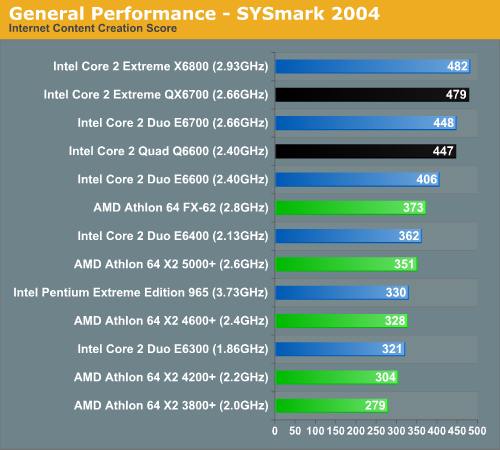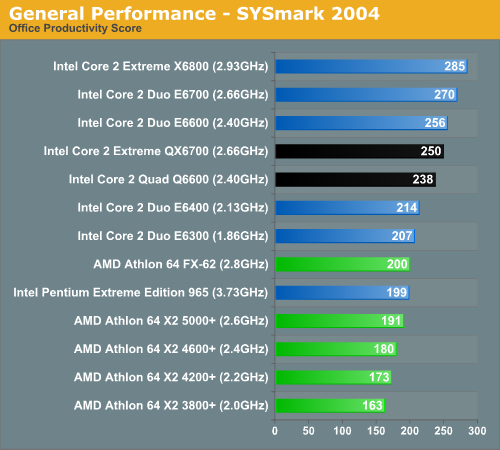Intel's Core 2 Extreme QX6700: The Multi-core Era Begins
by Anand Lal Shimpi on November 2, 2006 2:14 AM EST- Posted in
- CPUs
Application Performance using SYSMark 2004 SE
No article looking at a new processor release would be complete without benchmarks. However, let us preface the benchmark section by stating that the benchmarks don't tell the whole story. There are numerous benchmarks and tasks that you can run that will actually show quad core processors in a better light. A lot of people will never use the applications related to these benchmarks, so in one sense we could say that most people should already know whether or not they need quad core processing. There is also definitely an element of future proofing your system by purchasing quad core now, with the hope that it will be more useful at some point during the life of the system. We definitely do not expect to see large gains in performance in most of the benchmarks we will run, simply because they were not designed or optimized to run on multi-core systems. We will also have some benchmarks that clearly do show vast improvements by moving from dual cores to quad cores, although we've already seen coverage of this in our Kentsfield preview.

We'll start with SYSmark 2004, a benchmark suite that does have some multitasking components and multithreaded applications, but which also includes plenty of work that benefits very little from dual cores let alone quad cores. The overall scores show the quad core processors to basically be equal to their dual core counterparts in terms of performance, with the margin of error accounting for the slight differences in score. Having two more processor cores did almost nothing for SYSmark 2004, and we would expect that to be the case with many business/office applications. Drilling down into the individual results gives us a bit more information, however.


The Internet content creation score clearly does benefit by adding extra processing cores, although not a lot. The Core 2 Quad systems are more or less able to match Core 2 Duo chips clocked one bin higher. The Office Productivity scores show the exact opposite: Core 2 Quad chips are slower than Core 2 Duo chips with the same clock speed. In an ideal world, this shouldn't happen, as all other things being equal having more processor cores should not slow down your overall performance. At some low level, however, there appears to be some resource contention or operating system inefficiencies. The SYSmark 2004 overall score is a good representation of what the end-user will truly experience for this sort of application: the difference between dual cores and quad cores really isn't very apparent if you are a more or less "typical" user.










59 Comments
View All Comments
PrinceGaz - Thursday, November 2, 2006 - link
What do you mean it is "a insanely round-about way of measuring power draw"? Can you come up with a better one that doesn't involve cutting tracks on mobos to read the current being passed through them? Or a method which would work equally well with very soon to be released G80 graphics-core which is reputed to dissipate rather a lot of heat (clamp the water-block on that G80 and we'll soon see how much heat it really puts out).If you can come up with a simpler and better method of determining the power usage of CPUs and other devices, feel free to divulge the details here because their current method of measuring at the AC power-outlet is woefully inadequate, and I think a water-block heat-transfer system is not only a simple but quite accurate way of measuring power use, but one that can be applied to both CPUs and GPUs.
autoboy - Thursday, November 2, 2006 - link
Wow, all you guys have really weird methods of measuring power draw. Nearly all the power for modern processors comes through the 12V Aux power connector. You can measure the current and voltage here and you will get the power consumption of the processor. However, the efficiency of the VRM can skew the results slightly.Gigahertz19 - Thursday, November 2, 2006 - link
Ah I like the little hint on the transitor count for Nividia's G80 when they release next week. Can't wait till Nvidia's G80 is released and we get some benchies :)
fikimiki - Thursday, November 2, 2006 - link
Looking at pure encoding performance we can expect only 40-50% increase.It is very,very bad.
Why don't you compare this CPU with Dual-Core Opteron platform?
Without better cache management this CPU is only for benchmarks same as 4x4 it's with crazy pricing.
defter - Thursday, November 2, 2006 - link
Why compare cheaper single-socket platform with more expensive dual-socket platform?
Are you kidding? Kentsfield PC will be cheaper than 4x4 PC, if Kentsfield will achieve same level of performance, then it will have better price/performance ratio.
lopri - Thursday, November 2, 2006 - link
Damn.. I can't get over how gigantic those dice look together.msva124 - Thursday, November 2, 2006 - link
Is the article fully uploaded yet? I got some 404s as I was reading through it.xFlankerx - Thursday, November 2, 2006 - link
Fine for me now. NIce stuff too, as has come to be expected from AT.Chuske - Monday, December 25, 2017 - link
I come from the FUTURE !! In very late 2017, beggining of 2018, quad core CPUs are still very much in use .. even QX6700 and people favourite Q6600 (10$ now) held pretty well, for 11 yo cpus ..